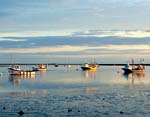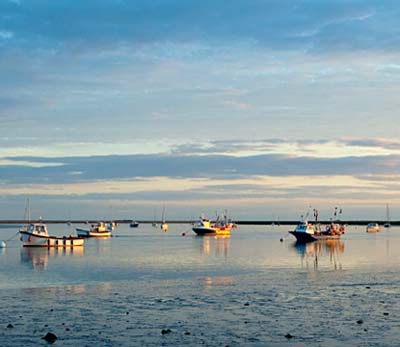Inspirational East Anglia
East Anglia’s other-wordly sense of space and light has inspired artists for centuries


The builders of Ely Cathedral did not intend it to be so picturesque. One of the towers of the west front collapsed, creating what, among English cathedrals, is a uniquely lopsided composition. The same fate befell the tower over the crossing. Ingeniously, the eight-sided void that this opened up was closed by an octagon, as glorious as a richly ornamented crown placed on the footstool of the roof. From a distance, it has an almost lacy silhouette. Before the fens were drained, it served a practical purpose, as a lighthouse to guide travellers over the treacherous bogs. Aesthetically, it gave the cathedral an unmistakable silhouette, fretted, in this land of low horizons, against the great, open immensity of the sky.
‘Overhead the arch of heaven spread more ample than elsewhere, as over the open sea; and that vastness gave, and still gives, such cloudlands, such sunrises, such sunsets, as can be seen nowhere else within these isles,' wrote Charles Kingsley in the prelude to Hereward the Wake. These days, the landscape below the skies is very different. Gone is the semi-amphibious life that appalled Samuel Pepys, when, wanting to see fair play about an uncle's will, he struggled to Wisbech in 1663. Embarrassed by his relations' poverty, he observed people ‘sometimes rowing from one spot to another, and then wadeing'. To cap it all, he was badly bitten by gnats.
Once Grunty Fen was drained in the 1860s, only Wicken Fen survived to recall what had been a landscape of tall reeds, yellow flag irises and dragonflies. Bought by the National Trust in 1899, it became England's first nature reserve. But it took the Fens some time to remember that they had been drained, and to stop themselves from flooding-old men recall how the floodwaters froze and became skating rinks (see Country Life, November 23, 2011). Agricultural efficiency during the Second World War consecrated their black earth to food production, and East Anglia changed from being one of the wettest to one of the driest regions of the country. But the skies remain.

Whittlesey-born Edward Storey, the living poet of the Fens, wrote of the ‘frightening proximity of the setting sun' in his wonderful Portrait of the Fen Country. Even from the self-contained comfort of their cars, drivers can feel a ghost of the trepidation that must have been experienced across the centuries, if they're out beneath the savagery of a blood-stained sunset, or the gathering, gunmetal gloom of winter. Ely Cathedral is still a welcome sight; the Old Fire Engine House, where tea awaits, even more so.
The skies give an epic quality to this land, and are not merely an adjunct, but an essential part of it-ever-changing, sometimes snow-capped, an avalanche of white cumulus or, on clear winter nights, an eternity of starry space. As Mr Storey describes: ‘These Fenland skies are to us as the Himalayas are to the world of Asia.' The great detective writer Dorothy L. Sayers, who had known the Fens intimately since childhood, when her father became vicar of Bluntisham-cum-Earith, evokes another mood.
The Nine Tailors opens: ‘It was past four o'clock and New Year's Eve; the snow that had fallen all day gave back a glimmering greyness to a sky like lead.' In Norfolk, the sky was not only wide, but could be portentous; until the 18th century, a belief persisted that the Milky Way had been put among the stars as a signpost to the Virgin Mary's house at Nazareth, re-created after a vision, and was known as the Walsingham Way as a result. Romantic as ever, Benjamin Disraeli brings the sky to his aid in his 1845 novel Sybil, when ‘a sudden flash of rosy light, suffusing the grey ruins, indicated that the sun had just fallen', and ‘alone in the resplendent sky, glittered the evening star'. From the Lady Chapel, a hymn to the Virgin is heard.
East Anglia isn't only sky. There are ponds, square-towered churches, estuaries, cottages, marl pits, heaths, a Nelson monument at Great Yarmouth, and Castle Rising, to which Isabella, the She-Wolf of France, was banished after her lover murdered her husband, Edward II: they all made subjects for the painters of the Norwich School, Britain's only regional school of painting. But go and see the works of these artists at the Castle Museum, Norwich, and it's obvious that the sky forms a major subject. What fun they had with it when gales stirred up the coast, imperilling the fishing smacks caught on the tossing waves.
Exquisite houses, the beauty of Nature, and how to get the most from your life, straight to your inbox.
‘Breadth must be attended to,' John Crome, founder of the Norwich School, advised his pupil James Stark, ‘if you paint but a muscle give it breadth.' Stark took this advice when painting Cromer, its clifftop church delicately, sedately still against an effervescent sky. A series of Crome's etchings in the museum depicts an open landscape with a windmill and a pond, where the brewing sky is, effectively, the subject: you can see it is, because in the later states some unfeeling print seller took it out, to give more prominence to the terrestrial scene, and ruined it completely.
But watercolour was, of course, the favoured medium, its transparency suited to the Cham-pagne freshness and rapid changes of the light, the water on the end of the brush about to tip down from the heavens. Even in the comparatively parched present day, the pre-valence of lodes, cuts, dykes, drainage ditches and sluices are watery enough to bestow an unusual luminosity on the skies above. If any painter had a practical knowledge of the weather, it was John Constable.
As a lad, he worked in one of his father's Suffolk windmills, where every changing nuance had to be understood in order to take maximum advantage of the wind. The focus stayed with him. Years later, in 1821-22, his interest quickened by the development of meteorology as a proto-science, he painted his remarkable studies of clouds-scudding, heaped, vaporous, creamy, leaden, sometimes annotated according to their classification. ‘I have done a good deal of skying,' he wrote to a friend in 1822. ‘I am determined to conquer all difficulties and that most arduous one among the rest... The sky is the source of light in nature-and governs everything.' Physically, these cloud studies were made on Hampstead Heath; emotionally, for a man who was so obsessed by the landscape of his childhood, they belong to East Anglia.
In such paintings, observed the film-maker Peter Greenaway in a catalogue essay for the Louvre, the ‘change of the landscape colour with such a racing light is extreme, it is nothing to measure twelve tones of green-ness on a light metre, with the edges of the cloud-shadow sometimes so sharp it is comparable to the switching on and off of an electric light'.
For another East Anglian, Edward Seago, the skies of his native land were similarly inescapable. His masterpiece was The Anvil Cloud, 1944, painted for, and given to, the Castle Museum. As the title suggests, it is a painting of a towering cloud formation, slashed through with sunlight: East Anglia through and through.
By then, the skies over East Anglia had taken on another personality, of which a hint remains at Little Snoring in Norfolk. ‘Active Airfield' proclaims the sign, sticking up from a base formed by an old car tyre. Flights of Lancasters used to roar into the sky from Little Snoring Airfield during the Second World War. Now, Little Snoring slumbers, woken only by the sound of the flying club, which maintains the serviceable runway. Up and away into East Anglia's big skies. If only Constable had had the chance.
* Subscribe to Country Life and save £40%
Country Life is unlike any other magazine: the only glossy weekly on the newsstand and the only magazine that has been guest-edited by His Majesty The King not once, but twice. It is a celebration of modern rural life and all its diverse joys and pleasures — that was first published in Queen Victoria's Diamond Jubilee year. Our eclectic mixture of witty and informative content — from the most up-to-date property news and commentary and a coveted glimpse inside some of the UK's best houses and gardens, to gardening, the arts and interior design, written by experts in their field — still cannot be found in print or online, anywhere else.
